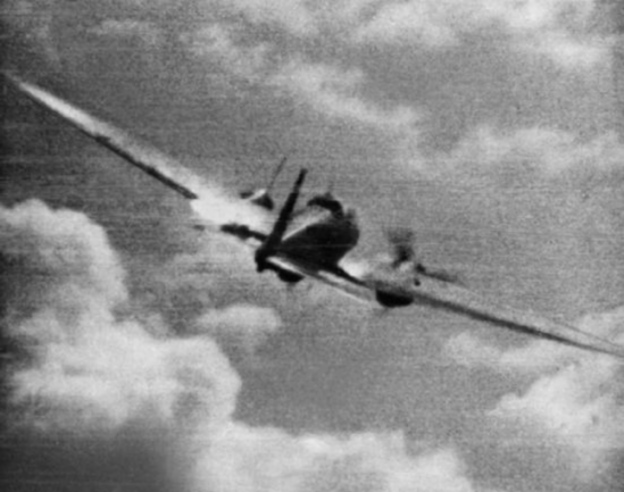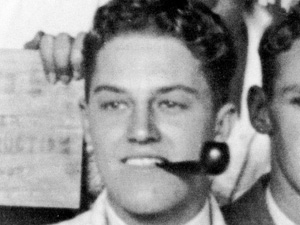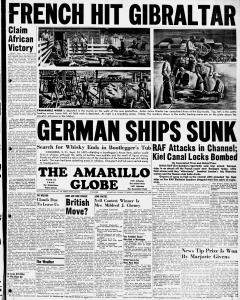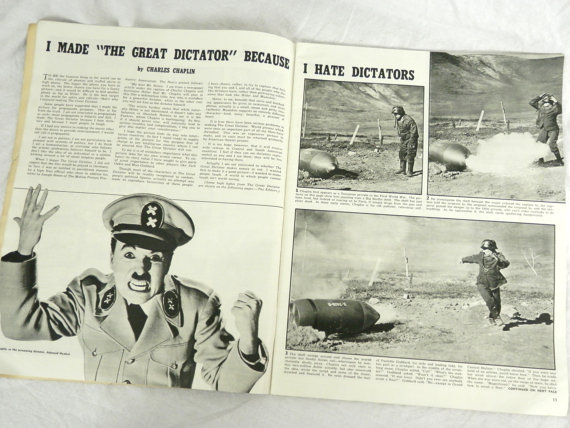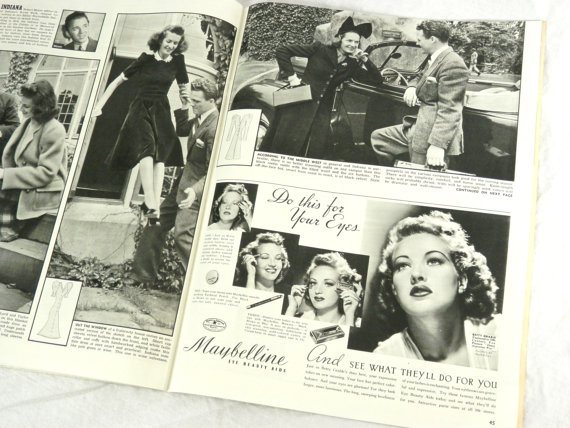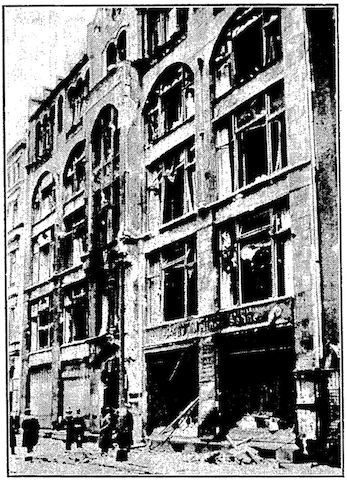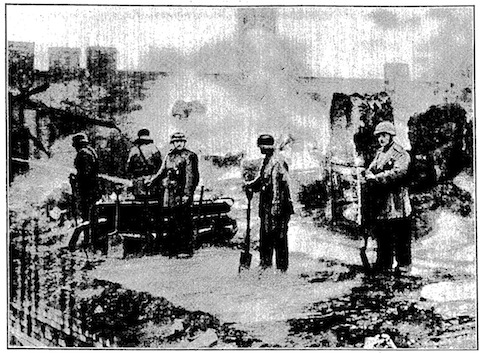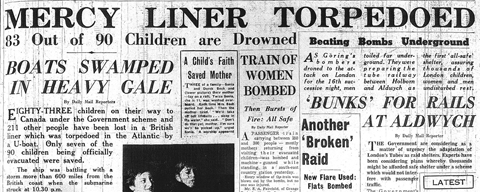Wednesday 1 January 1940
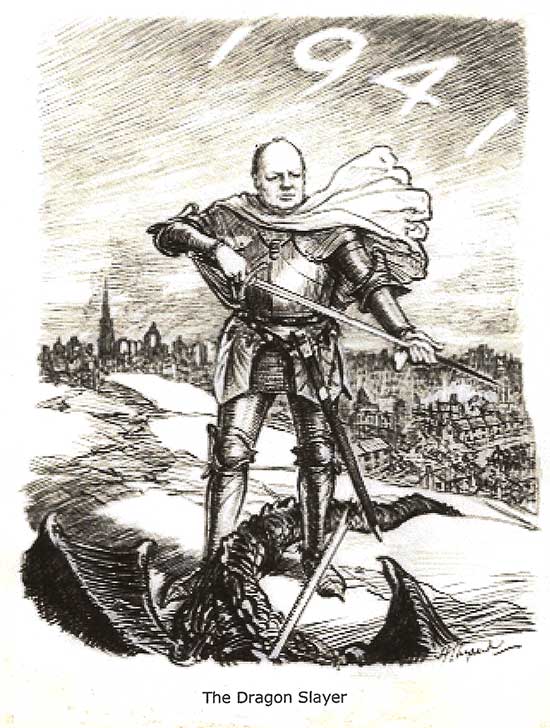 |
| Churchill as St. George the Dragon Slayer, By E.H. Shepard, 'Punch', January 1, 1941. It is refreshing to see Churchill caricatured as something other than a bulldog. |
European Air Operations: RAF Bomber Command sends 95 bombers against the port of Bremen, which has an important Focke-Wulf aircraft factory. Another 46 bombers attack other various other targets. Some sources say that 141 bombers attack Bremen, but that appears to have been all the planes used on various missions, which included attacks on Flushing, Ostend, and Brest.
The Luftwaffe, meanwhile, resumes night bombing after taking the previous two nights off. However, they go off course and bomb Dublin and four other Irish counties (Counties Meath, Carlow, Kildare, Wicklow, Wexford and Dublin). Three people perish in Darlow, and there are injuries there and in the other counties.
As of the first of the year, the two Luftflotten facing England, 2 and 3, have a total of 1214 aircraft. This is down from 1291 in September when the area bombing campaign against England began. However, front-line strength only tells part of the story: many of those bombers are in the shop awaiting repair or overhaul (such as engine replacement). Whereas in September about 20% of the planes were in the shops, as of early January the number is almost 50%. The cause is not so much RAF defenses as the almost daily use of the equipment in difficult weather.
Generalmajor Theo Osterkamp becomes Jagdfliegerführer 2 (commander of the fighter aircraft in Luftflotte 2).
The Luftwaffe continues transferring units to the Mediterranean. III,/ZG 26 begins the journey today, flying to the Treviso coast. The ultimate destination is Tripoli.
Lt. Rudolf Stradner of 1,/NJG 2 shoots down his first victim, a Wellington I of RAF No. 301 Squadron near Digby at 22:25.
Battle of the Atlantic: Five Royal Navy destroyers intercept a French convoy of four ships off Gibraltar which are headed to France from Casablanca. After a brief fight in which destroyer HMS Jaguar fires upon 9986-ton freighter Chantilly (2 dead, four wounded), the Vichy ships are taken to Gibraltar.
A force of light Royal Navy light cruisers and destroyers conducts Operation DZ, a minelaying operation off Jaederens Point and Obrestad.
British 1016 ton freighter Attendant hits a mine off Sheerness in the Thames Estuary. The crew beaches it, and then it is refloated and towed to Gravesend for repairs.
Dutch coaster Catharina collides with Norwegian freighter Madrono in the English Channel south of the Lizard in Cornwall. The Catharina sinks, but everybody survives.
Convoy OB 268 departs from Liverpool, convoy FN 373 departs from Southend, Convoy FS 377 departs from Methil, Convoy SL 61 and SLS 61 depart from Freetown, Convoy HX 100 departs from Halifax, Convoy BHX 100 departs from Bermuda.
Royal Navy light cruiser HMS Mauritius is commissioned.
U-216 is laid down.
Royal Navy trawler HMS Bandelero collides with HMAS Waterhen in the Gulf of Sollum and sinks. Some sources place this on 30 December 1940.
The Southern Rhodesia Air Force (SRAF) bombs Italian positions at Keru, east of Kassala.
The Indian 7th Infantry Brigade arrives at Port Sudan from Egypt.
Spy Stuff: British Scotland Yard police break into the home of Free French Vice-Admiral Émile Muselier and arrest him on charges of high treason. Muselier is de Gaulle's commander of Free French naval forces. The police have in their possession four incriminating documents, including a letter in which the Admiral acknowledges receipt of 2,000 pounds sterling in exchange for information about the (failed) British attack on Dakar (Operation Menace) in September. Another document shows that Muselier was plotting to transfer the French submarine Surcouf to the Vichy French government.
Muselier, according to the information in the possession of the British, communicated through the Brazilian Embassy. Churchill is furious and wants to line the Admiral up against a wall and declare war on Brazil for good measure. However, cooler heads prevail and an investigation is launched. General de Gaulle stands beside Admiral Muselier and works to clear him.
As it turns out, the letters supposedly incriminating Muselier have been forged. The culprit is the former head of security of the Free French headquarters in London who recently has been fired due to internal intrigue there. Right-wingers (known as "Cagoulards") and supporters of the leftist Popular Front have been fighting for priority and the usual favoritism. This security man, known as "Howard" but apparently a Captain Collins, has used a forger named "Colin" to craft the documents in order to discredit Muselier. Howard and Colin both confess, and Admiral Muselier is released within about a week.
The whole affair further roils the Free French cause because Muselier suspects that de Gaulle set him up, while de Gaulle suspects the British intelligence service, MI5, of setting him up. Meanwhile, Muselier may not be a traitor, but he is a serious piece of work who seems determined to embarrass everyone who comes in contact with him at some point or another.
In actuality, neither MI5 nor de Gaulle was involved in this, Muselier was simply being used as a pawn in a continuing battle between people within the Free French movement but at opposite ends of the political spectrum. The so-called Cagoulards, who may somewhat simplistically be thought of as Monarchists, generally have the upper hand with de Gaulle, and this is an attempt to disrupt that influence. This internal battle against the communists - and them firing back - has been waging throughout the war and takes many twists and turns.
The entire affair is a tremendous embarrassment for everyone. The British Foreign Secretary is forced to write a contrite letter of apology:
Dear Admiral Muselier,
I have been charged to convey to you an expression of the deep regret of His Majesty's Government that you should have been detained by the British authorities on suspicions which have now been proved to be unsubstantiated.
His Majesty's Government have satisfied themselves that the documents, which at first appeared to cast suspicions on you, are spurious. As soon as this conclusion was reached, instructions were given for your immediate release.
His Majesty's Government look forward to continuing their collaboration with yourself and with the Free French Naval Forces under your command, which are rendering such signal services to the Allied cause.
I would beg at the same time to convey the regrets of His Majesty's
Government to Lieutenant Villers.
With renewed and deep regrets, believe me,
Yours sincerely,
Anthony Eden
 |
| New Zealand Home Guard, 1 January 1941 (Sir George Grey Special Collections, Auckland Libraries, AWNS-19410326-30-2). |
US/Japanese Relations: US Ambassador to Japan Joseph Clark Grew confides to his diary that:
Japan . . . is on the warpath . . . If . . . Americans . . . could read . . . articles by leading Japanese . . . they . . . would realize the utter hopelessness of a policy of appeasement.Grew sees growing militarism in Japan and is actively looking for ways to communicate that to the US government.
Soviet Military: Georgy Zhukov prepares to command "Western" or "Blue" forces in a war games exercise that simulates a German invasion. His opponent is Colonel General D. G. Pavlov, the commander of the "Eastern" or "Red" forces. The exercises are to begin on 2 January 1940.
Holland: During the month, the occupation authorities clamp down on people's ability to listen to anything related to the Allies, such as BBC and Radio Orange from the Dutch government-in-exile. These Allied broadcasts already are forbidden, but now even broadcasts based in the Netherlands are heavily restricted. Broadcasting of English and American songs is forbidden, and radio stations are ordered to play approved German shows such as "Wunschkonzert" (a call-in song request show) and "Gruss aus der Heimat" ("Greetings from the Fatherland").
Canada: CBC (for Canadian Broadcasting Corporation) is formed.
 |
| The Coca-Cola float at the 52nd Tournament of Roses Parade held on 1 January 1941. It shows pandas climbing a giant iceberg, apparently to get at a coke. |
The effect of the Orders (the announcement continues) is that if any person prints, publishes, or distributes, or is in any way concerned in printing, publishing, or distributing either of these papers, he will be committing an offence.The rest of the media is supportive of this measure, as even the most sympathetic outlets consider the Daily Worker "dishonest" in its supposed support of the working man.
The Forces radio service airs "The Brains Trust" for the first time. Created by BBC producers Howard Thomas and Douglas Cleverdon, it at first is called "Any Questions?" The program proves popular right from the beginning despite - or perhaps because of - its high-brow aspect. The Brains Trust, apparently named after a Roosevelt Administration term, remains on the air for decades, and last appeared in the early 2000s.
American Homefront: A major snowstorm begins in the Midwest. It will lead to immense snowfall in Minnesota, Iowa, and nearby states.
The American Society of Composers, Authors, and Publishers (ASCAP) engages in a sort of strike. It removes all of its music from the airwaves over a licensing dispute. This will last for most of 1941.
The Stanford Indians defeat the Nebraska Cornhuskers 21-13 in the 27th Rose Bowl, while the Boston College Eagles beat the Tennessee Volunteers 19-13 in the 1941 Sugar Bowl and the Mississippi State Maroons defeat the Georgetown Hoyas 14-7 in the Orange Bowl. Many consider this to be the Boston College Eagles' best team in its history.
In Chicago's Chicago Stadium, Detroit Red Wings player Jimmy Orlando punches out a fan, knocking him out. Orlando then escapes into the night before a wild melee results, with berserk fans storming the ice seeking revenge.
Incidentally, a lot of sources claim that Jimmy Stewart was sworn in as a member of the US Air Corps on this date. I'm unable to find any confirmation of this whatsoever. Stewart was initially drafted in October 1940 but failed the physical for weight reasons. He did get in during March 1941 after strenuous effort. How 1 January 1941 became his supposed date of entry is a bit of a mystery, but I put it here because perhaps I overlooked something.
 |
| The war news fights for attention with the football games, The Baltimore News-Post, 1 January 1941. |
December 1941
December 1, 1940: Wiking Division FormsDecember 2, 1940: Convoy HX 90 Destruction
December 3, 1940: Greeks Advancing
December 4, 1940: Italian Command Shakeup
December 5, 1940: Thor Strikes Hard
December 6, 1940: Hitler's Cousin Gassed
December 7, 1940: Storms At Sea
December 8, 1940: Freighter Idarwald Seized
December 9, 1940: Operation Compass Begins
December 10, 1940: Operation Attila Planned
December 11, 1940: Rhein Wrecked
December 12, 1940: Operation Fritz
December 13, 1940: Operation Marita Planned
December 14, 1940: Plutonium Discovered
December 15, 1940: Napoleon II Returns
December 16, 1940: Operation Abigail Rachel
December 17, 1940: Garden Hoses and War
December 18, 1940: Barbarossa Directive
December 19, 1940: Risto Ryti Takes Over
December 20, 1940: Liverpool Blitz, Captain America
December 21, 1940: Moral Aggression
December 22, 1940: Manchester Blitz
December 23, 1940: Hitler at Cap Gris Nez
December 24, 1940: Hitler at Abbeville
December 25, 1940: Hipper's Great Escape
December 26, 1940: Scheer's Happy Rendezvous
December 27, 1940: Komet Shells Nauru
December 28, 1940: Sorge Spills
December 29, 1940: Arsenal of Democracy
December 30, 1940: London Devastated
December 31 1940: Roosevelt's Decent Proposal
January 1941
January 1, 1941: Muselier ArrestedJanuary 2, 1941: Camp Categories
January 3, 1941: Liberty Ships
January 4, 1941: Aussies Take Bardia
January 5, 1941: Amy Johnson Perishes
January 6, 1941: Four Freedoms
January 7, 1941: Pearl Harbor Plans
January 8, 1941: Billions For Defense
January 9, 1941: Lancasters
January 10, 1941: Malta Convoy Devastation
January 11, 1941: Murzuk Raid
January 12, 1941: Operation Rhubarb
January 13, 1941: Plymouth Blitzed
January 14, 1941: V for Victory
January 15, 1941: Haile Selassie Returns
January 16, 1941: Illustrious Blitz
January 17, 1941: Koh Chang Battle
January 18, 1941: Luftwaffe Pounds Malta
January 19, 1941: East African Campaign Begins
January 20, 1941: Roosevelt 3rd Term
January 21, 1941: Attack on Tobruk
January 22, 1941: Tobruk Falls
January 23, 1941: Pogrom in Bucharest
January 24, 1941: Tank Battle in Libya
January 25, 1941: Panjiayu Tragedy
January 26, 1941: Churchill Working Hard
January 27, 1941: Grew's Warning
January 28, 1941: Ho Chi Minh Returns
January 29, 1941: US Military Parley With Great Britain
January 30, 1941: Derna Taken
January 31, 1941: LRDG Battered
2020





